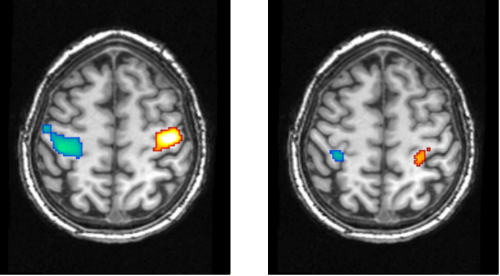12.23.2011
Scientists Measure Dream Content
>

Max Planck and Charité Hospital researchers have succeeded in analyzing the activity of the brain during dreaming.
They did this with the help of lucid dreamers, people who become aware of their dreaming state and are able to alter the content of their dreams. The lucid dreamers were asked to become aware of their dream while sleeping in an MRI scanner and to report this “lucid” state to the researchers by means of eye movements. They were then asked to voluntarily “dream” that they were repeatedly clenching first their right fist and then their left one for ten seconds.
This enabled the scientists to measure the entry into REM sleep — a phase in which dreams are perceived particularly intensively — with the help of the subject’s electroencephalogram (EEG) and to detect the beginning of a lucid phase. The brain activity measured from this time onwards corresponded with the arranged “dream” involving the fist clenching.

From Kurzweil AI
New Research on Dreams and the Brain from the Max Planck Institute
A region in the sensorimotor cortex of the brain, which is responsible for the execution of movements, was actually activated during the dream. The coincidence of the brain activity measured during dreaming and the conscious action shows that dream content can be measured. “With this combination of sleep EEGs, imaging methods and lucid dreamers, we can measure not only simple movements during sleep but also the activity patterns in the brain during visual dream perceptions,” says Martin Dresler, a researcher at the Max Planck Institute for Psychiatry.
The researchers were able to confirm the data obtained using MR imaging in another subject using a different technology. With the help of near-infrared spectroscopy, they also observed increased activity in a region of the brain that plays an important role in the planning of movements. “Our dreams are therefore not a ‘sleep cinema’ in which we merely observe an event passively, but involve activity in the regions of the brain that are relevant to the dream content,” explains Michael Czisch, research group leader at the Max Planck Institute for Psychiatry.
Ref.: Martin Dresler, et al., Dreamed Movement Elicits Activation in the Sensorimotor Cortex, Current Biology, 2011;
They did this with the help of lucid dreamers, people who become aware of their dreaming state and are able to alter the content of their dreams. The lucid dreamers were asked to become aware of their dream while sleeping in an MRI scanner and to report this “lucid” state to the researchers by means of eye movements. They were then asked to voluntarily “dream” that they were repeatedly clenching first their right fist and then their left one for ten seconds.
This enabled the scientists to measure the entry into REM sleep — a phase in which dreams are perceived particularly intensively — with the help of the subject’s electroencephalogram (EEG) and to detect the beginning of a lucid phase. The brain activity measured from this time onwards corresponded with the arranged “dream” involving the fist clenching.

From Kurzweil AI
New Research on Dreams and the Brain from the Max Planck Institute
A region in the sensorimotor cortex of the brain, which is responsible for the execution of movements, was actually activated during the dream. The coincidence of the brain activity measured during dreaming and the conscious action shows that dream content can be measured. “With this combination of sleep EEGs, imaging methods and lucid dreamers, we can measure not only simple movements during sleep but also the activity patterns in the brain during visual dream perceptions,” says Martin Dresler, a researcher at the Max Planck Institute for Psychiatry.
The researchers were able to confirm the data obtained using MR imaging in another subject using a different technology. With the help of near-infrared spectroscopy, they also observed increased activity in a region of the brain that plays an important role in the planning of movements. “Our dreams are therefore not a ‘sleep cinema’ in which we merely observe an event passively, but involve activity in the regions of the brain that are relevant to the dream content,” explains Michael Czisch, research group leader at the Max Planck Institute for Psychiatry.
Ref.: Martin Dresler, et al., Dreamed Movement Elicits Activation in the Sensorimotor Cortex, Current Biology, 2011;
Labels: kurzweil, max-planck, sensorimotor

